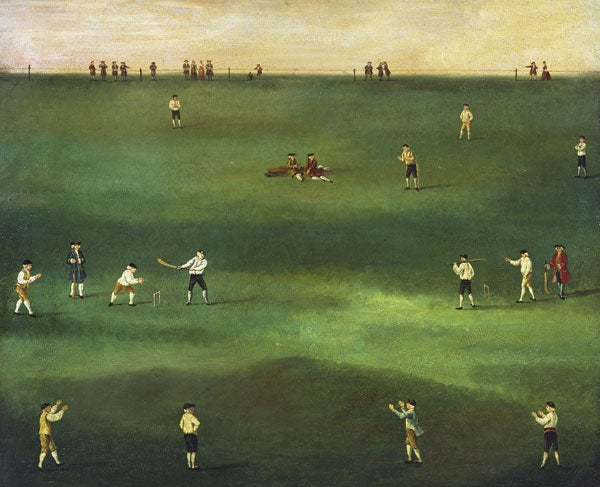Great Works: An Exact Representation of the Game of Cricket (circa 1760), Louis Philippe Boitard
Tate London

The Swiss art historian, Heinrich Wölfflin, once asserted that all pictures owe more to other pictures than they do to direct observation. When you first come across it, it seems either a doubtful or a disheartening idea. What about originality? What about perception? Is art only a matter of one image recycling another one? Can't a picture break out of established pictorial habits?
Perhaps it can. But the more artistic picture may be the less likely place to look. A landscape painter will be pulled towards certain ideas of views and composition. However disorderly nature in the raw may be, the existing templates will, willy-nilly, guide the eye and the hand.
But there are some truly unruly pictures. It can happen when the subject is previously almost unknown; when there is no customary treatment or genre. Look at An Exact Representation of the Game of Cricket. It's not a great work. It's by an anonymous painter, copied from an obscure artist, Louis Philippe Boitard. It crudely shows an early game of cricket in progress. It's an attempt at pure documentary. There's nothing like it of its time.
Is it a landscape? Not remotely. Its subject is an empty stretch of field, with no trees, no hills, and very little sky, populated with isolated figures. The ground is viewed almost from above, in terms of how the players are placed – though in terms of how individual players are viewed, they are each seen from the side. Meanwhile, at the top, the spectators stand in a row along a horizon. The perspectives are contradictory. You couldn't call this an exact observation. But attempting to convey information, this "view" owes very few debts to other pictures.
And notice for a moment, not the picture's view, but its composition. There's a narrow band of flat off-white across the top of the picture; beneath it, a broad band of green, with darker and lighter greens crossing it. This is like a modern abstract painting. It can't be intended, not remotely. The effect is simply coincidental. But in composition too, this picture has no debts. Or you might simply say: it has ground and it has sky, yes, but it has no composition at all. Information is all.
How about its figures, then, and their patterns? The cricket field offers the strangest formations. It's not really a game with two halves. It has some visual regularities and certain symmetries. The two batsmen face each other; bowler and wicketkeeper do, to an extent, too. But apart from that, the fielders are set out in various positions, at various distances and directions from the pitch, distributed all over the field. Among the field sports, cricket is the odd one. All the others have inherent doubles, balances, centres, echoes, wings, goals. Even when at stasis, cricket is in disarray.
This anarchic pattern is observed in An Exact Representation of the Game of Cricket, up to a point. There are irregularities, as there should be, but they're not quite irregular enough. There are too many neat relationships among the players, and between them and the picture as a whole. The wicket lies horizontally and centrally in the picture. And the four fielders standing along the front are much too paced and balanced – all on a line, a pair on the left and the right. Only with the four other fielders, higher up in the field, do you get a sense of cricket's "wild" configuration.
Meanwhile another kind of abstraction appears. It's not a matter of horizontal bands now. It's a matter of elements laid out on a ground – these figures dotted all over the field. Is this a possible composition? Or is it an anti-composition, which defies any predictable order?
The arrangement of a cricket field is of course filled with human purposes. It has a design. It has positions with definite reference to the where the ball is likely to strike off from the batsman, and has to be caught, stopped, thrown etc. But in this process it doesn't create any visible order among the fielders, not even a complicated one. It isn't random, but it looks random. Transferred onto a pictorial field, it becomes a scattering.
An Exact Representation of the Game of Cricket can't bring itself to go the whole way. The regularities it introduces onto the field shows a reluctance to depart from clear visible orders. At some points it loses pattern entirely, and goes wild. At others, it recoups. But it goes far enough to allow any composition to go into free-fall. It finds an exit from the world of existing pictures.
"All reality is iconoclastic," said C S Lewis. Reality, truly seen, will break through or break down the images created in our minds. Even the game of cricket, exactly represented, can challenge all our human plans.
About the artist
Louis Philippe Boitard (active 1734–1763) is an artist about whom little can be said, not even his dates of birth or death. He was a book illustrator and draughtsman of contemporary life. He was born in France, son of François Boitard, who did the same thing, and came with his father to England, probably in the first quarter of the 18th century, where he married and settled. He produced rather Hogarthian images of London life. They are very conventional scenes. Only the 'Exact Representation' breaks out of his habits. There is another copy, though inferior, held at Marylebone Cricket Club.
Subscribe to Independent Premium to bookmark this article
Want to bookmark your favourite articles and stories to read or reference later? Start your Independent Premium subscription today.

Join our commenting forum
Join thought-provoking conversations, follow other Independent readers and see their replies